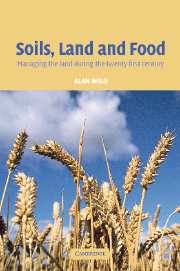Book contents
- Frontmatter
- Contents
- Preface
- Acknowledgements
- 1 Managing land for food production in the twenty-first century: an outline
- 2 Natural resources for sustainable land management
- 3 The development of agriculture and systems of land management
- 4 Maintaining and improving soil fertility
- 5 Land degradation and its control
- 6 Raising yields: use of fertilizers
- 7 Raising yields: water for rainfed crops and irrigation
- 8 Managing change of land use: seven examples
- 9 Increasing and sustaining agricultural production
- 10 Increasing agricultural production: the examples of Africa, India and China
- 11 Prospects and uncertainties
- References
- Index
1 - Managing land for food production in the twenty-first century: an outline
Published online by Cambridge University Press: 05 June 2012
- Frontmatter
- Contents
- Preface
- Acknowledgements
- 1 Managing land for food production in the twenty-first century: an outline
- 2 Natural resources for sustainable land management
- 3 The development of agriculture and systems of land management
- 4 Maintaining and improving soil fertility
- 5 Land degradation and its control
- 6 Raising yields: use of fertilizers
- 7 Raising yields: water for rainfed crops and irrigation
- 8 Managing change of land use: seven examples
- 9 Increasing and sustaining agricultural production
- 10 Increasing agricultural production: the examples of Africa, India and China
- 11 Prospects and uncertainties
- References
- Index
Summary
POPULATION AND FOOD REQUIREMENTS
Agriculture is often seen as conservative in the sense that it changes only slowly. There are good reasons why this change is slow: agriculture is a complex activity that has to be adapted to particular environmental conditions, there must be no risk to food for the family, and the farmer has to perceive a material and usually financial benefit of any changes. It is nevertheless reasonable to assume that from the start of agriculture change has taken place in response to change in demand. The gradual change from hunting and gathering that supported limited, mobile populations to an increasing dependence on settled agriculture led to more and more people needing more productivity from the land.
Archaeological and historical records tell us about early innovations, for example the evolution and spread of the deliberate production of crops in different parts of the world aided by the introduction of such techniques as the animal-drawn plough, irrigation and terracing. Up until the last few centuries changes to agricultural practices occurred slowly. The changes became more rapid with the expansion of cultivation into new lands, with an increase in the human population and, especially from the sixteenth century, with the spread of crops between continents and countries and the development of more farm implements.
In the nineteenth and twentieth centuries the increase in demand for agricultural products was met by the use of more land, the introduction of higher-yielding crops and domesticated animals, and the use of fertilizers and pesticides.
- Type
- Chapter
- Information
- Soils, Land and FoodManaging the Land during the Twenty-First Century, pp. 1 - 8Publisher: Cambridge University PressPrint publication year: 2003



